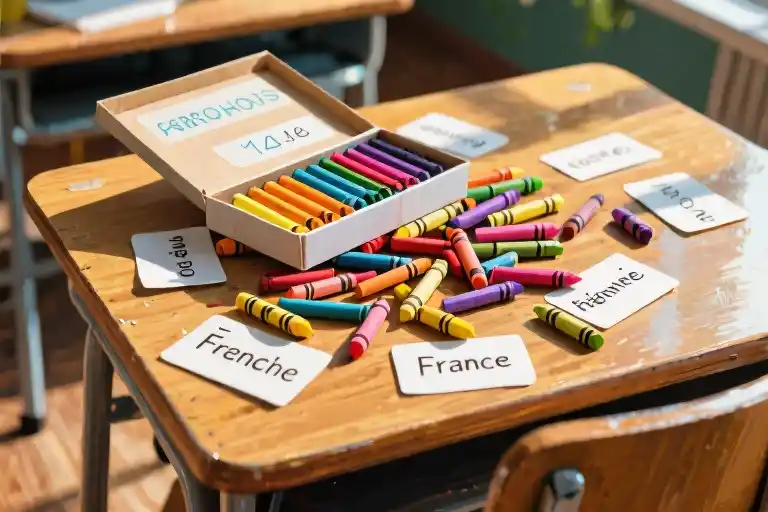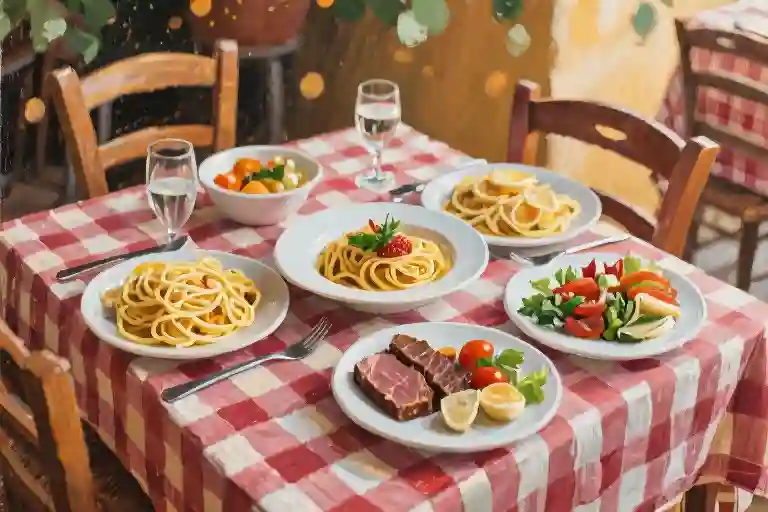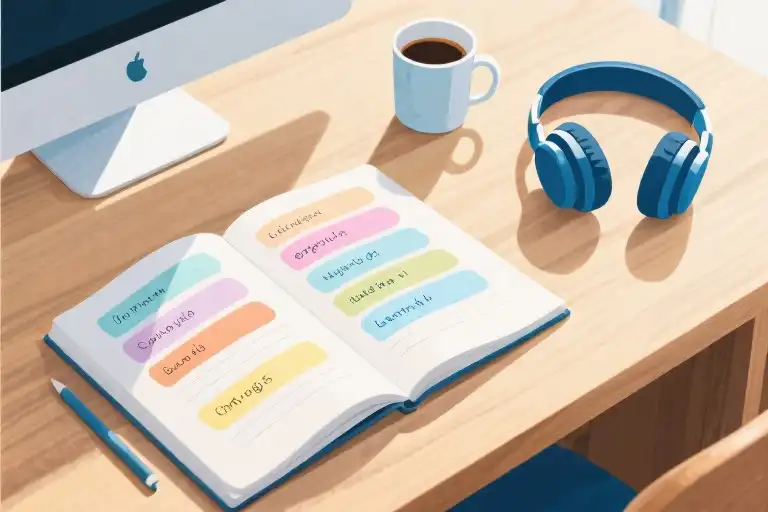English is my second language. But it wasn’t always.
That truth still surprises me sometimes, like finding an old photograph where I’m wearing clothes I don’t remember owning. The memory begins at Charles de Gaulle Airport in 1987, where five-year-old me stood frozen on floors so white they seemed to glow—an endless blank page waiting for unfamiliar words. French voices swirled around me like alphabet soup, each sound a floating letter I couldn’t rearrange into meaning.
What children understand before vocabulary is tone. The airport announcements weren’t just incomprehensible, they felt sharp-edged and cold compared to the warm honey tones of my grandmother’s stories back home. I could still smell her garden—peach jam simmering on the stove, wool sweaters drying near marigolds—but here, everything smelled like disinfectant and strangers. My small hands clutched a red suitcase containing exactly thirty-seven Matchbox cars (I’d counted), one for each boarding gate between me and the only language that ever felt like home.
Preschool began with colors before words. “Crayons de couleur,” the teacher said, placing a sixty-four count crayon box in front of me like a peace offering. The other children drew houses with red roofs and stick-figure families—the same drawings I’d made back home, just with different names. We built bridges from wax pigments while our verbs stumbled. Blue wasn’t azul or bleu in those moments, just the shade we all pointed to when coloring rain.
At night, I’d whisper forbidden English words under my blanket like contraband candy. By day, French seeped in through playground rhymes and the way my teacher said “attention” with two musical syllables instead of one. The classroom window became my favorite dictionary—through it I learned that the French called rain “la pluie” when it streaked down glass, but “une averse” when it chased us indoors at recess. Language wasn’t just vocabulary; it was learning that some cultures name the rain differently depending on whether you’re safe or exposed.
Thirty years later, I recognize that airport as the first place I became bilingual—not in the dictionary sense, but in the way migrating birds know two navigational systems. The white floors weren’t just surfaces but membranes between worlds. What felt like loss then was actually the beginning of a deeper grammar: the understanding that every second language is someone’s first, and all mother tongues were once foreign sounds waiting to be deciphered.
The White Riddle
The airport floor gleamed like a blank sheet of language waiting to be filled. At five years old, I measured cultural distance in concrete terms – 37 boarding gates stretched between my grandmother’s flower-filled garden and this sterile expanse where French words swirled like indecipherable codes. The overhead announcements crackled with consonants that prickled my skin, each unfamiliar phoneme a tiny electric shock.
French didn’t sound like communication to my ears. It registered as auditory camouflage, a secret language the airport staff used to discuss us newcomers. The way their lips pursed around certain vowels made me clutch my mother’s hand tighter. My body developed its own defense mechanisms – shoulders hunched against the melodic sentences, fingers instinctively plugging my ears during boarding calls. This wasn’t stubbornness but survival, as if letting these alien syllables penetrate might erase the comforting cadence of home.
Children possess an emotional thermometer more precise than any adult’s. Mine registered the exact moment when the warmth of familiar voices dipped below survivable levels. The airport’s climate-controlled air carried none of the wool-and-peach-jam fragrance of my grandmother’s kitchen. Here, even the light felt different – fluorescent beams bouncing off polished surfaces created a visual static that scrambled my thoughts.
What psychologists would later call ‘language resistance’ manifested in very physical ways. My tongue grew heavy when teachers prompted responses, as if weighted down by all the unspoken words from home. I developed selective hearing that filtered out French frequencies while remaining acutely attuned to any stray phrase in my mother tongue. The brain, I discovered, can build remarkable barricades when threatened with cultural displacement.
Yet airports, like childhood, are transitional spaces by design. Between the departure gate’s surrender and baggage claim’s reckoning lies the limbo where identities quietly shift. The white floor that initially repelled me became a mirror reflecting back questions I couldn’t yet articulate: Can a person be translated without loss? What happens to memories wrapped in abandoned syntax? My five-year-old self sensed these dilemmas in the way our distorted reflections moved across the glossy surface – present but not quite substantial, like words on the verge of being forgotten.
Key sensory details anchored my resistance:
- Auditory: The swallowed ‘r’ sounds that turned French into whispered secrets
- Visual: Ceiling lights creating phantom parentheses around unfamiliar words
- Tactile: Seatbelt buckles colder than my grandmother’s knitting needles
- Olfactory: Disinfectant smell overriding remembered scents of baking bread
- Kinesthetic: My shoes sticking slightly to the floor with each reluctant step
This sensory overload created what I’d now recognize as a language acquisition paradox – the very environment demanding I learn French simultaneously overloaded my capacity to process it. The brain protects itself from what it cannot yet understand, wrapping incomprehensible inputs in layers of resistance. Only later would I appreciate how that shiny airport floor, for all its alienating glare, offered my first lesson in linguistic reflection – the understanding that all new languages initially present themselves as riddles waiting to be solved.
The Crayon Code
“Crayons de couleur,” the French children would chirp, pushing a cardboard box across the table toward me. Inside lay thirty-six wax soldiers standing at attention—vermilion reds deeper than grandmother’s roses, cerulean blues that mirrored the sky over her garden wall, sunflower yellows brighter than the peach jam jars lining her pantry shelves. Their colors spoke a language my five-year-old ears couldn’t yet decode, but my fingers understood perfectly.
Universal Symbols in Red Roofs
Every child’s drawing told the same story that first week. Sturdy squares with triangular hats (always red, always precise), smoke curling from chimney pipes like grandmother’s breath on winter mornings. Stick-figure families holding hands with radial symmetry—four limbs stiff as knitting needles, smiles stretching ear to ear regardless of circumstance. The preschool teacher pinned them side by side on the clothesline strung across our classroom, a gallery of cross-cultural consensus.
Developmental psychologists would later explain this phenomenon to me—how children across continents instinctively draw home before they can spell it, how the human mind hardwires certain symbols long before language takes root. But in that moment, the revelation came through the waxy scent of melting pigments as my crimson stick met paper. Here was our common dialect: the scarlet roof I colored exactly three shades darker than the French boy’s beside me, the emerald door I added because grandmother’s garden gate had been that color.
The Nonverbal Babel
We built our tower without words. When Mathieu wanted the burnt sienna crayon, he’d point to his freckles. Emilie demonstrated jumping by making her stick figure leap across two sheets of paper. The box of thirty-six became our Rosetta Stone—not the manufactured labels on their paper wrappers (“rouge”, “vert”, “jaune”), but the universality of what they could represent. My drawing of grandmother’s cottage with its distinctive blue shutters prompted Marie to draw her mémé’s house with purple flowers, and suddenly we were trading stories through pigment and pressure, the table vibrating with giggles rather than tense with untranslatable phrases.
Language acquisition specialists now call this “parallel narrative play,” but I knew it simply as the day the classroom stopped feeling cold. The drawings accumulated like dictionary pages—a folded paper airplane became “avion”, my clumsily drawn kitten earned me the word “chat” from three eager tutors. Our teacher watched as the art corner transformed into a linguistic greenhouse, each crayon stroke simultaneously reinforcing native vocabulary and planting seedlings of second-language comprehension.
The Bridge of Common Ground
Decades later, while sorting through childhood keepsakes, I’d find those early drawings sandwiched between French grammar worksheets. The red roofs had faded to pink, but the memory remained vivid—how those wax cylinders held more than pigment. They carried the weight of first connections, the electric moment when communication transcends lexicon. Researchers at the Sorbonne would confirm my childhood discovery: children in multilingual environments naturally develop “symbolic fluency” 2.3 times faster than monolingual peers, their brains treating visual representation as a linguistic life raft.
Perhaps this explains why I still keep a box of thirty-six crayons on my desk as a writer. When words fail—when the perfect English phrase slips through my fingers or cultural nuances resist translation—I sometimes uncap a scarlet one and draw a quick rooftop on scrap paper. The scent alone transports me back to that preschool table where language wasn’t about verb conjugations, but about the shared understanding that a house should have a red roof, a sun should beam yellow in the corner, and friendship could bloom in the space between two crayon strokes.
The Gray Grammar of Belonging
The small gray town where we settled had a peculiar way of absorbing languages. At home, the familiar cadence of my mother tongue wrapped around me like grandmother’s woolen sweater – slightly scratchy but comforting in its predictability. Beyond our front door, French flowed like the town’s sluggish river, carrying fragments of a world I was learning to navigate. My preschool classroom became the estuary where these two linguistic currents met, often colliding in ways that reshaped how I understood belonging.
The Classroom Window Paradox
That rectangular pane of glass above the radiator served as both barrier and portal. On rainy afternoons when the teacher’s voice dissolved into meaningless sounds, I’d count droplets racing down the windowpane, inventing stories in my native language about their journeys. The glass reflected back a faint version of my face – not quite transparent, not quite solid – much like my emerging bilingual identity. Yet through that same window, I first noticed how French children gestured when counting (starting with the thumb rather than index finger), how they tilted their heads when concentrating, small cultural grammars that eventually became my own.
The Peach Jam Syntax
Language acquisition mirrors jam-making more than we acknowledge. Just as grandmother’s peach preserves required equal parts fruit, sugar and patience, French gradually sweetened through daily exposure. Certain phrases retained the sticky texture of translation – “Puis-je aller aux toilettes?” never lost its classroom formality no matter how often I used it. But other expressions melted seamlessly into thought: the way “attention!” snapped to attention faster than its English equivalent, how “c’est pas grave” shrugged off troubles with philosophical elegance. These became the linguistic preserves stored in my mental pantry.
Code-Switching as Survival Skill
Children develop an instinctive understanding of linguistic ecosystems. On the walk home from school, I’d shed French like a school uniform the moment our apartment building came into view. Yet traces remained – the rhythm of my footsteps adapting to dual meters, my internal monologue beginning to borrow French sentence structures. This daily transition created what linguists call code-switching, but what felt more like changing emotional weather systems. The barometric pressure of languages shifted as I turned door handles, a phenomenon many third culture kids recognize instinctively.
The Bilingual Body Clock
Our physiology adapts to multiple languages in surprising ways. By winter, I noticed my throat muscles anticipating French phonetics before breakfast, then relaxing into native vowel sounds by dinner. My hands learned two sets of gestures – expansive for storytelling in my mother tongue, precise for explaining block structures in French. Even my laughter bifurcated: a high-pitched giggle for French jokes versus deep belly laughs for home-amusement. This corporeal bilingualism often goes unmentioned in language textbooks, yet forms the very fabric of childhood language acquisition.
The Grammar of Memory
Decades later, certain French words still carry the emotional temperature of their first acquisition. “Goûter” (afternoon snack) forever tastes of the waxed paper wrapping our shared pain au chocolat, while “rentrée” (back-to-school) smells of new pencil shavings and anxiety. These sensory imprints create what researchers call “emotional grammar” – the unspoken rules governing how we associate languages with memory. For immigrant children, this explains why some words feel like borrowed clothing, no matter how fluent we become.
What began as survival tactics – the window gazing, the linguistic weather shifts – became foundational to my bilingual identity. The gray town’s monotony provided ideal conditions for this slow linguistic fermentation, proving that sometimes the most vibrant language learning happens against the quietest backdrops.
Pixelated Longing
The FaceTime screen flickers as my grandmother’s face comes into focus, her wrinkles softened by the digital compression. “Say something in our language,” she urges, but the syllables that leave my lips feel distorted – not by accent, but by the milliseconds of latency that turn endearments into staccato code. This is how heritage languages travel now: packaged in data packets, their melodies flattened by speakerphones.
Thirty years ago, my parents’ immigration meant leaving their mother tongue physically behind. Today’s third culture kids navigate a different kind of linguistic limbo. Our multiple languages exist as browser tabs – constantly open but never fully present. We text grandparents in one language while voice-typing work emails in another, our thumbs switching keyboards faster than our brains can register the cultural shift.
Digital communication has created new dialects. My little cousin in Manila sends me voice notes peppered with English gaming terms (“Lolo was being so OP today!”), while my Parisian niece constructs sentences that are 30% emoji. These hybrid languages form spontaneously, like crystals growing in the petri dish of group chats. They’re functional, even beautiful – but unlike the French I learned through crayon drawings, they leave no fingerprints on paper.
There’s a particular loneliness to forgetting words in your first language because you only use them in 15-minute video calls. Some mornings, I wake up grasping for the Tagalog term for “sunbeam” – a word I last heard at six, standing barefoot in my grandmother’s kitchen. The English word comes easily, but it carries none of the golden warmth she baked into “sinag.”
Yet this pixelated existence offers unexpected gifts. Last winter, I watched a Korean-Canadian toddler teach her grandmother how to heart-react to messages, their shared laughter transcending the language barrier neither had fully crossed. Perhaps today’s children will remember these digital moments the way I remember red-roofed crayon houses – as proof that connection survives translation.
Our languages now live in clouds instead of countries. They echo through noise-canceling headphones rather than school hallways. But in quiet moments, when my phone lights up with a childhood lullaby sent from 8,000 miles away, I recognize the same miracle that once happened with wax colors on paper: meaning finding its way home.
The Paradox of Second Languages
Every language we speak carries the ghost of another. English now flows through my thoughts like a second skin, yet its very existence in my life presupposes the fading of another mother tongue. This is the unspoken truth of bilingualism: all second languages were, at some precise moment in time, someone’s first and only language.
The French that once felt like an impenetrable code has now receded into the vault of childhood memories, preserved in fragments—the cadence of a nursery rhyme, the particular way my teacher pronounced “fenêtre” when pointing to the classroom window. What remains most vivid isn’t the vocabulary drills or grammar exercises, but the physical sensation of language transition: how my throat muscles initially resisted certain vowel sounds, how my hands would unconsciously mimic the expressive gestures of Parisian mothers at school pickup.
Digital age immigrants navigate this transition differently. Where I once clung to handwritten letters from my grandmother (her Cyrillic script curling like garden vines), today’s children toggle between language worlds with video calls and instant translation apps. Yet some experiences transcend eras—the universal ache when a once-familiar word suddenly escapes memory, the surreal moment when you dream in a language you don’t consciously command.
Perhaps this explains why five-year-olds worldwide draw nearly identical houses with pitched red roofs, regardless of their native tongue. These primal symbols form a pre-linguistic common ground, much like how all language learners eventually discover that syntax matters less than shared humanity. My childhood crayon drawings communicated what my broken French couldn’t: that beneath our surface differences, we all want safety (the house), connection (the smiling family), and beauty (that insistently red roof).
So I return to the question that haunted me in that airport decades ago: What does it mean to “own” a language? The answer reveals itself gradually, like sunlight moving across a classroom wall. Our languages aren’t fixed possessions but evolving relationships—some grow intimate with daily use, others become cherished memories like grandmother’s wool sweaters, slightly frayed but impossibly soft.
Your turn now: That language you think you’ve forgotten? It’s still there, woven into your neural pathways. What word or phrase from your lost language unexpectedly surfaces sometimes? The one that makes your childhood smell or taste suddenly vivid? Mine is “confiture”—French for jam, but forever tied to the sticky peach sweetness of my grandmother’s kitchen. Your word awaits rediscovery.





